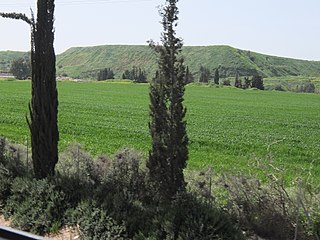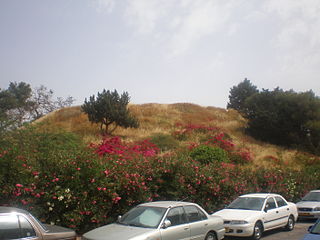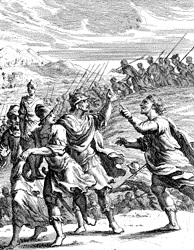 W
WBenebarak was a biblical city mentioned in the Book of Joshua. According to the biblical account it was allocated to the Tribe of Dan.
 W
WDan is a city mentioned in the Hebrew Bible, described as the northernmost city of the Kingdom of Israel, and belonging to the tribe of Dan. The city is identified with a tell located in northern Israel known as Tel Dan in Hebrew, or Tell el-Qadi.
 W
WAccording to the Book of Genesis, Dan was the fifth son of Jacob and the first son of Bilhah. He was the founder of the Israelite Tribe of Dan. In the biblical account, Dan's mother is described as Rachel's handmaid, who becomes one of Jacob's wives.
 W
WTel Gerisa (Hebrew) or Tell Jerishe and Tell Jarisha (Arabic), commonly known as Tel Napoleon or Napoleon's Hill, is an archaeological site on the southern bank of the Yarkon River in Israel. The main phases of the city are dated to the Middle and Late Bronze Ages, with a smaller settlement in Iron Age I and going into decline in Iron Age II.
 W
WThe fabled Kingdom of Simien, sometimes referred to as the Kingdom of Beta Israel, refers to a legendary kingdom of the Beta Israel putatively located in the northwestern part of the Ethiopian Empire.
 W
WSimon Magus, also known as Simon the Sorcerer or Simon the Magician, was a religious figure whose confrontation with Peter is recorded in Acts 8:9–24. The act of simony, or paying for position, is named after Simon who tried to buy his way into the power of the Apostles.
 W
WManoah is a figure from the Book of Judges 13:1-23 and 14:2-4 of the Hebrew Bible. His name means "rest".
 W
WThe narrative of Micah's Idol, recounted in the Book of Judges, concerns the Tribe of Dan, their conquest of Laish, and the sanctuary that was subsequently created there.
 W
WIn the Hebrew Bible, Oholiab, son of Ahisamakh, of the tribe of Dan, worked under Bezalel as the deputy architect of the Tabernacle and the implements which it housed, including the Ark of the Covenant. He is described in Exodus 38:23 as a master of carpentry, weaving, and embroidery.
 W
WIn the Hebrew Bible, Samson was the last of the judges of the ancient Israelites mentioned in the Book of Judges and one of the last leaders who "judged" Israel before the institution of the monarchy. He is sometimes considered to be an Israelite version of the popular Near Eastern folk hero also embodied by the Sumerian Enkidu and the Greek Heracles.
 W
WThe Tel Dan Stele is a fragmentary stele containing a Canaanite inscription, discovered in 1993 in Tel-Dan by Gila Cook, a member of an archaeological team lead by Avraham Biran, the pieces having been used to construct an ancient stone wall that survived into modern times. The stele is in several pieces and contains several lines of Aramaic, closely related to Hebrew and historically a common language among Jews. The surviving inscription, which dates to 9th century BCE, details that an individual killed Jehoram, the son of Ahab, king of Israel and the king of the house of David. These writings corroborate passages from the Bible, as the Second Book of Kings mentions that Jehoram, also Joram, is the son of an Israelite king, Ahab, by his Phoenician wife, Jezebel. Applying a Biblical viewpoint to the inscription, the likely candidate for having erected the stele is Hazael, an Aramean king who is mentioned in Second Book of Kings as having conquered the Land of Israel, though he was unable to take Jerusalem. The stele is currently on display at the Israel Museum, and is known as KAI 310.